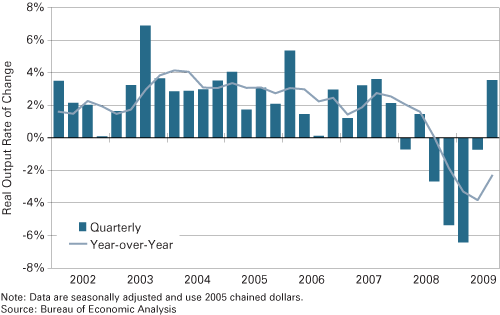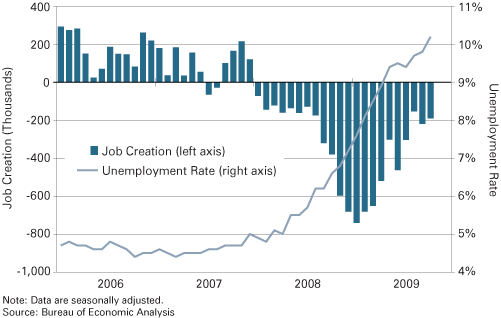U.S. Outlook for 2010
Co-Director, Center for Econometric Model Research, Indiana University Bloomington
November 2009
A year ago, as our Outlook Panel traveled the state, the U.S. economy had absorbed a series of body blows that pushed it into an abyss whose depth was far from clear. We anticipated a painful descent, with output falling through the middle of 2009, accompanied by significant decline in employment and rising unemployment.
As shown in Figures 1 and 2, this was qualitatively an accurate prognosis. However, quantitatively the economy has done far worse than our “relatively optimistic scenario.” From the peak of the cycle in the second quarter of 2008 through the low point in the second quarter of 2009, the output of the U.S. economy real gross domestic product (GDP) decreased by over 3.8 percent. Through October 2009 (starting in January 2008) job loss has totaled over 7.3 million (with some still to come), and unemployment has more than doubled to 10.2 percent. All three of these numbers are well above our year-ago expectations.
Figure 1: U.S. Real Output Quarterly and Annual Rate of Change, 2002 to 2009

Figure 2: U.S. Job Creation and Unemployment Rate, January 2006 to October 2009

Looking ahead, we have a “good news, bad news” message. The good news is that we expect 2010 to be substantially better than 2009. The bad news is that it might not feel all that much better and there are some very large problems if one looks further into the future.
We think that the bottom of the recession was reached during the past summer, and that the third quarter of 2009 marks the beginning of a recovery period. However, as has been true of the past two recoveries, the labor market is likely to lag the overall recovery. To be more specific:
- We expect output to grow throughout 2010, with growth for the year of about 3.5 percent, somewhat above the long-run average. This is good, but given the depth of the downturn, not exceptional. There may be some upside potential beyond our outlook.
- Employment will not begin to grow until early in 2010 (lagging the turn in output by about six months). Total job loss will reach close to 8 million. Unemployment will peak about the same time at a little above 10 percent. The recovery will not be strong enough to reduce unemployment to more normal levels for several years; by the end of 2010, it will still exceed 9 percent.
- Inflation has fallen significantly from the energy price-driven levels of 2008. It will remain well contained during 2010.
- The Federal Reserve, which lowered its target for the federal funds rate very close to zero in November 2008, will hold rates at that level until at least mid-2010. It may begin to restore short-term rates to more normal levels during the second half of the year.
So we see an economic recovery during 2010, with moderate output expansion, low inflation, and some decline in unemployment later in the year. What’s wrong with that? Two things: First, the recovery is much less than one might expect after such a severe downturn. Second, there are significant reasons to worry about its sustainability beyond 2010.
Both of these concerns are directly related to the primary causes of what has become the worst recession since the Great Depression. To simplify, the current recession resulted from the bursting of speculative bubbles in real estate and commodity markets, causing a near collapse of the financial system. The latter was countered by unprecedented intervention by central banks and governments around the globe, but especially by the Federal Reserve and the U.S. Treasury. Together these two agencies pumped close to $2 trillion of support into financial markets. In addition, at the behest of the Obama administration, Congress passed a stimulus package well in excess of $700 billion. These events and reactions leave the economy in a very difficult situation, both near term and especially longer term.
The standard recovery scenario revolves around household spending. It runs something like this: during a recession, households, faced with uncertainties about employment and income, become cautious. But once the cycle turns up, optimism returns and households open their wallets, perhaps even making up for lost time. As consumption revives, business investment follows to provide the capacity to meet increasing sales.
This time around, however, the standard scenario is dubious on three grounds:
- The housing collapse and financial crisis have done major damage to household balance sheets. The most significant asset of the typical American household is their house. Until the past few years, it was an asset whose value had never declined. Now it has.
- An important asset for many households is funds in 401k plans, IRAs, and similar saving plans. Such “defined contribution” plans have increasingly supplanted the traditional “defined benefit” pensions of an earlier period. With defined contribution plans, the impact of a financial collapse falls on household balance sheets.
- Faced with this double whammy, households have a lot of repair work to do. This will require higher saving at the expense of consumption. So the implication is a weak recovery unless something else picks up the slack.
One possibility could be the government. With stimulus package spending pouring out during the next year, this will, to a considerable extent, be the case. However, and this is the second problem ahead, governments also face budget constraints. The federal deficit next year will be the largest in our history except for the peak years during World War II. Such a situation is not sustainable. But restoring fiscal balance can only come about in two ways: lower government spending or higher government revenue (taxes). Either of these has negative short-run implications for the economy.
Finally, sometime in the next year or so, the Fed will probably face the need to remove the liquidity it injected during the financial crisis. Doing so will almost certainly mean higher interest rates—perhaps substantially higher. Again, this could have negative implications for the recovery.
Put these three components together and the prospects for a quick recovery followed by sustained robust expansion must be viewed with skepticism. Still, the prospects for the period immediately ahead are for a return to some growth, with the labor market following. That is far better than what we faced a year ago.
Also in this Issue…
- Outlook for 2010
- International Outlook for 2010
- U.S. Outlook for 2010
- Financial Outlook for 2010
- Housing Market Outlook for 2010
- Indiana's Outlook for 2010
- Indiana's Agricultural Outlook for 2010
- Anderson Forecast 2010
- Bloomington Forecast 2010
- Columbus Forecast 2010
- Evansville Forecast 2010
- Fort Wayne Forecast 2010
- Gary Forecast 2010
- Indianapolis-Carmel Forecast 2010
- Kokomo Forecast 2010
- Lafayette Forecast 2010
- Louisville Forecast 2010
- Muncie Forecast 2010
- Richmond Forecast 2010
- South Bend and Elkhart Area Forecast 2010
- Terre Haute Forecast 2010




